Off the wall: The artists who are the face of the Gulf street art scene
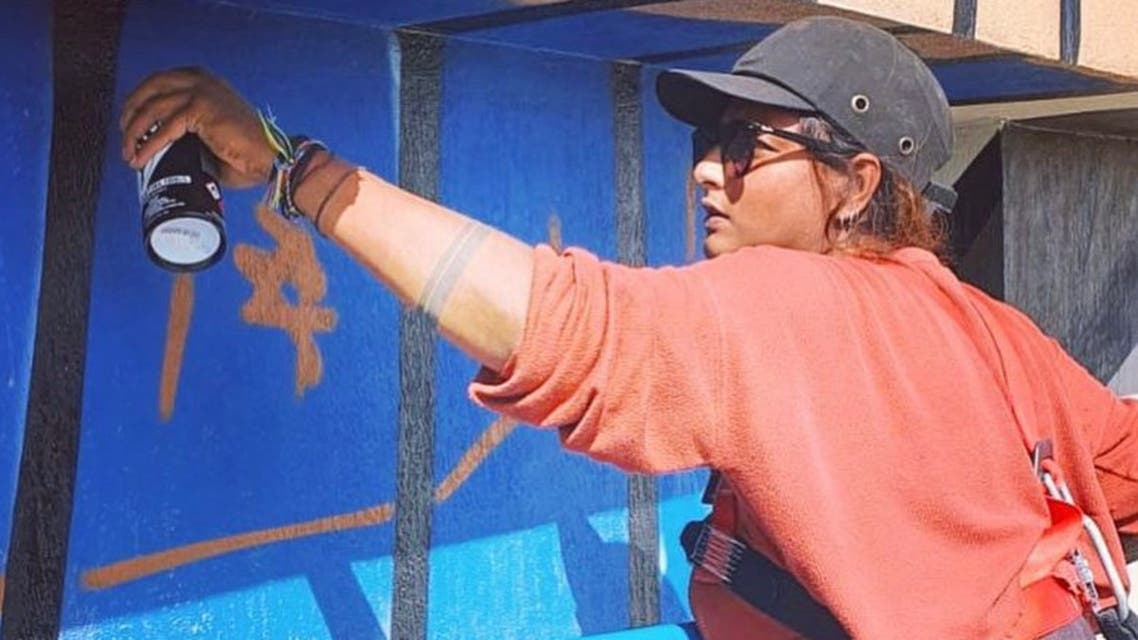
Dubai-born and raised artist Fathima Mohiuddin draws the glimpses from passers-by as splashes color onto a giant seven-story building on the outskirts of Abu Dhabi. (Supplied)
WHILE WEARING FALL PROTECTION SHE IS NOT WEARING PPE FOR SPRAY PAINTING
Jennifer Bell, Al Arabiya English
Jennifer Bell, Al Arabiya English
Published: 28 May ,2022
Spray can in her tattooed hand and baseball cap perched in her head, Dubai-born and raised artist Fathima Mohiuddin draws the glimpses from passers-by as splashes color onto a giant seven-story building on the outskirts of Abu Dhabi.
From the UAE to Qatar, larger-than-life murals are increasingly being splashed on the side of buildings, car parks, and underpasses across the region – and it is women who are behind the street art.
A rising collective of artists across the GCC are aiming to change a cultural mindset about street art, from its association with graffiti and vandalism to expressive art that’s publicly available to the masses.
Mohiuddin is part of the street art scene in the UAE and is responsible for some of the hundred-foot high murals on multi-storey buildings across the country.
Mohiuddin – reputed for her bird-themed series, including one which depicts a falcon in preparation for flight, splashed across a seven-storey building in Abu Dhabi’s in Yas Island – said over the past years the UAE has welcomed more and more public art.
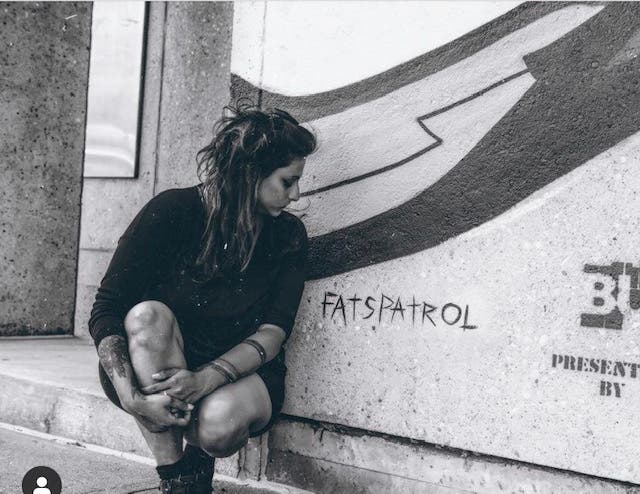
From Abu Dhabi to Dubai, Fathima Mohiuddin’s iconic work is capturing the attention of both residents in the country – and the international art scene. (Supplied)
She believes this changing mindset is beginning to be echoed across the region.
“There’s definitely activity in countries such as Bahrain, Kuwait, Qatar and Saudi already,” said the artist. “The thing is that it starts, in theory, as subcultures, underground movement and then surfaces and becomes more publicly noticed and acknowledged.
“In the UAE it’s just taken on a strong commercial presence quite quickly. Perhaps because the UAE is very liberal.
“I can imagine women in other GCC countries might face more challenges in this respect. But there was just a street art festival in Qatar, there have been in Kuwait, there are definitely street artists paving the way in Saudi.”
Mohiuddin, an Indo-Canadian artist, said her foray into street art began after returning to the UAE from London a completing a masters course focused on art in public spaces.
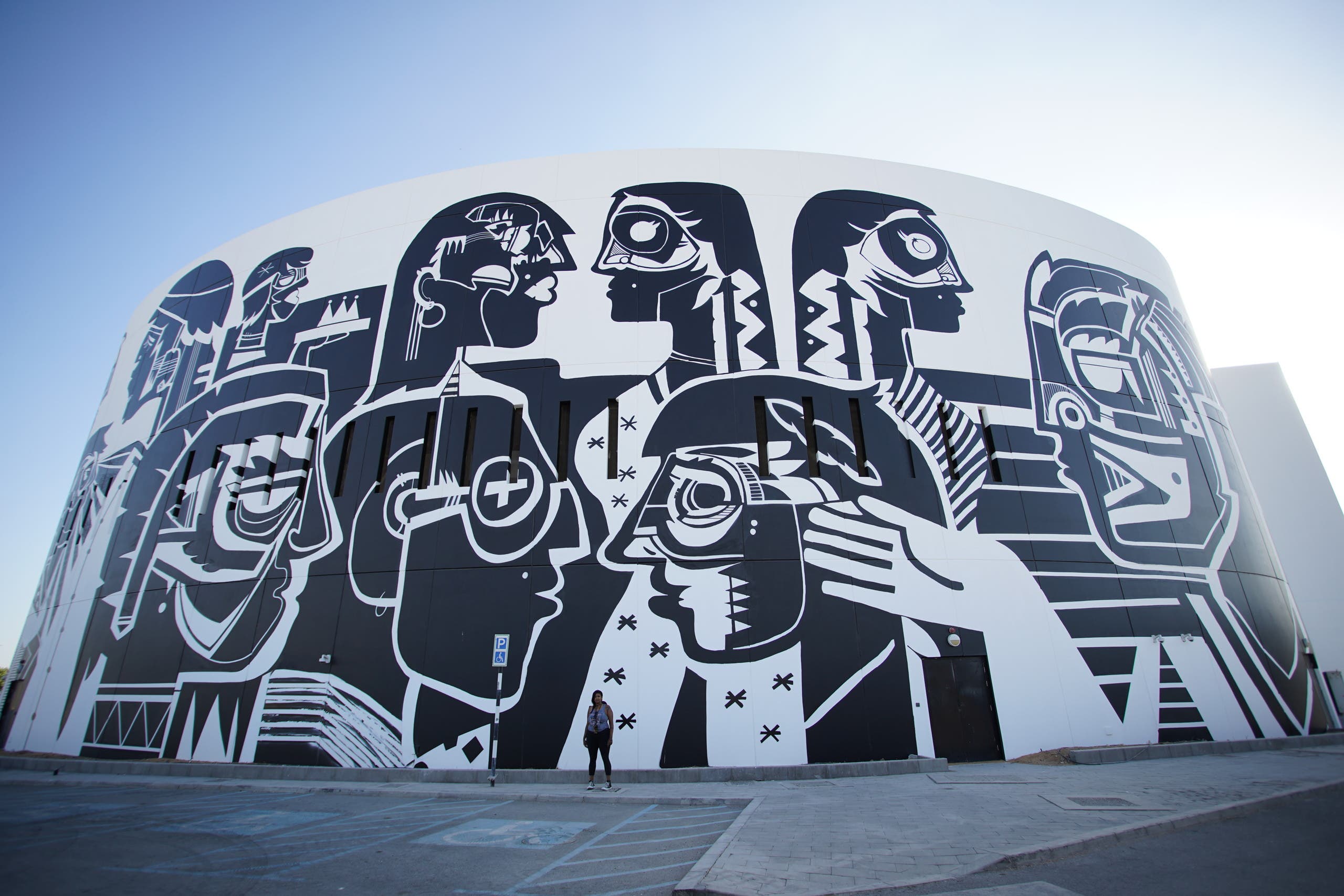
Fathima Mohiuddin’s work is displayed in Abu Dhabi’s Yas Island. (Supplied)
Her first outdoor mural in the UAE was in 2009 for the Dubai Community Theatre and Arts Centre where Mohiuddin worked as the gallery and project manager at the time. She then, in 2011, founded the artist-run entity The Domino, a platform for street artists in Dubai.
“We started out doing small live pop-up gigs at events, working with brands like Tiger Beer, Red Bull and Adidas. “And I think that’s probably where it’s progressed the most, painting murals is something a fair few artists are able to do full time now. There is a commercial demand for it, there are corporate budgets and artists can sustain doing just that. In that way, the scale of things has changed a lot.”
'The growing street art scene allows artists to connect with a large number of eyeballs in, says Mohiuddin, “a massive way.”
“It is also taken more seriously now; we’re able to get respectable budgets and it has become a place artists from around the world want to come paint.
“It’s important to recognize the journey that got us here I think. It didn’t happen overnight. A lot of people worked really hard and handled a lot of challenges to pave the way for where the scene is now.”
Mohiuddin, who has about 10,000 followers on Instagram, began to get noticed for her work in the UAE and was approached to display her work globally.
She now has work depicted in 10 counties across the world with her signature style splashed across shipping containers, cars, walls and skate parks in some of the biggest global cities.
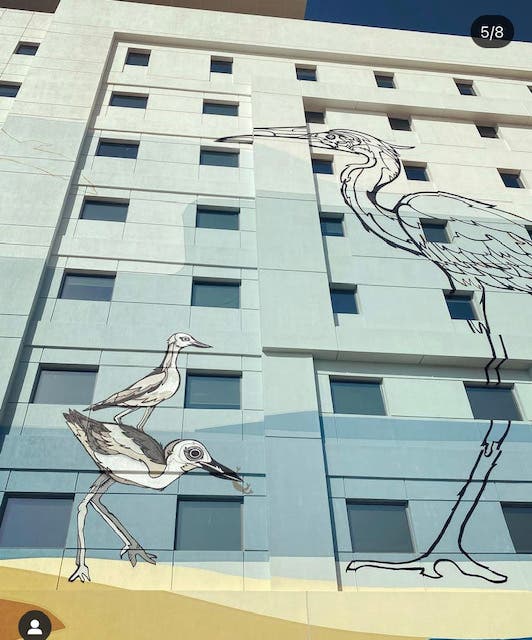
Birds, she said, have been an important theme in Mohiuddin’s work over the past six years. (Supplied)
To date, she has street art in Dubai, Abu Dhabi, Muscat, Bristol, London, Vienna, Waterford, New York, New Jersey, Toronto, Calgary, Mexico City, and Adelaide.
“I’m always proud of a public wall when I finish it because I know I’ve worked hard to get there, I know it’s still a big deal for women from this part of the world, women of colour, South Asian women.
“And the walls that go on to have a lifespan past a year are really exciting because they have this whole journey of their own after you leave them. You see photos pop up of people posing with them, you know people are having their own kind of experience and dialogue with them and that’s a pretty neat feeling that you left something somewhere that now has a life of its own.”
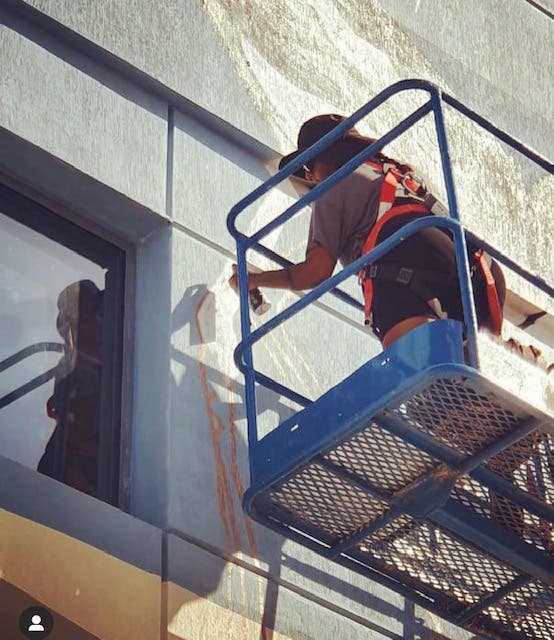
Dubai born street artist Fathima Mohiuddin at work. (Supplied)
As being both a female and a Dubai-born street artist, Mohiuddin said she is often met with surprise when people ask what she does as a career.
“I think the most common response is “cool!”. There’s a bit of rock and roll to it in some way. I think, particularly because I go by the name‘ fatspatrol’ and my work is not obviously feminine, people do say they were also surprised that ‘that’ was painted by a woman.
“However, I do also face challenges being taken seriously on work sites sometimes which I think has to do with me being a woman.”
Fellow street artist, Assil Diab, who goes by her street artists name ‘Sudalove’, is known for her work in Qatar.
The 33-year-old Sudanese began graffitiing as a teenager however, she only picked up her first spray can in 2012 when she was commissioned for an art series in Qatar following her Bachelor of Fine Arts (BFA) in the US.
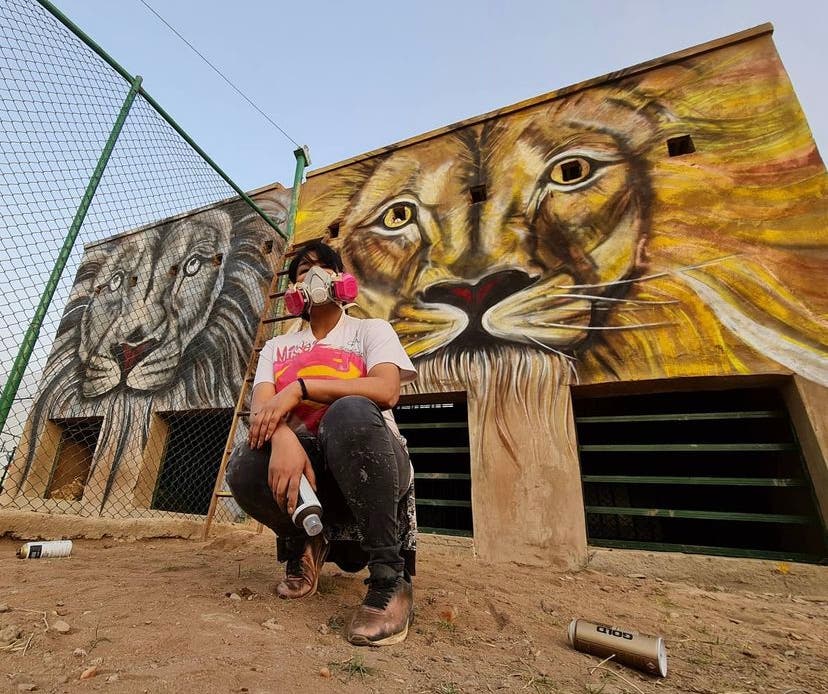
Fellow street artist, Assil Diab, who goes by her street artists name ‘Sudalove’, is known for her work in Qatar. (Supplied) WEARING PROPER PPE
“I took up an internship with Ashghal and Qatar Museums to assist the infamous El Seed (a French-Tunisian contemporary artist whose practice crosses the discipline of painting and sculpture) to paint 52 panels of the Salwa road tunnels in Doha.
“That is where I first picked up a spray can and really picked up all the techniques and never put the spray can down after that experience.
“Ultimately, I set up an Instagram and started posting my work here and there I started to get gigs. I remember I got paid double what I used to make monthly in my office job for a two-week job and I was in love with the art form and the power of expression I felt through it, so I decided to do this for a living in 2014 onwards.”
Most of her work in Qatar is commissioned and she is provided with a space or canvas.
“I’ve painted in Qatar and Bahrain thus far (in the region). I don’t see how you can paint freely if it isn’t commissioned, the scenes are different. Especially Qatar has vastly grown in the past five to 10 years there are a lot more buildings and construction sites underway. It would be impossible to randomly paint on any wall, and also illegal.
“Personally, I haven’t had a problem making a living as a street artist as I would’ve elsewhere, and I believe that is so for two factors; that there is a lack or a small number of street artists in the region and also people are now more into supporting women’s role in the workforce.
“I think some people love commissioning me for the fact that I am a female versus other factors, for example, it is just a little more entertaining to see a woman from this region doing it because it is so rare.
“Street art has always been a male-dominated art form however this is slowly changing and also much more artists in this part of the work are getting into it and the numbers are greatly increasing.”
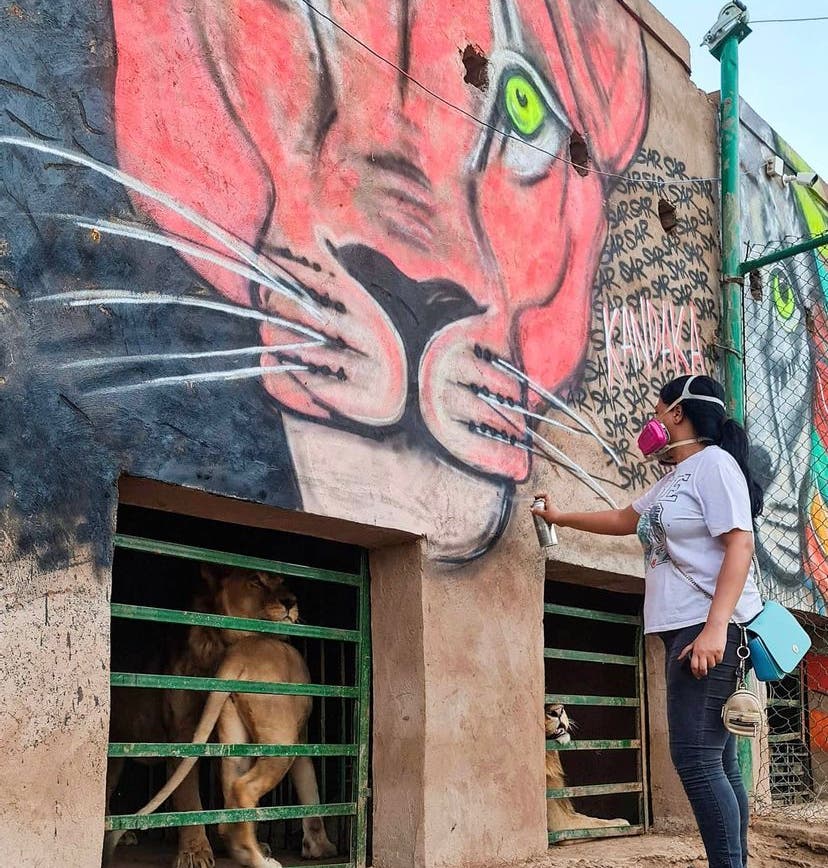
Fellow street artist, Assil Diab, who goes by her street artists name ‘Sudalove’, is known for her work in Qatar. (Supplied)
Professional artist Maddy Butcher began spray painting murals shortly after arriving in Dubai from New York in 2011. She has had large works commissioned across the UAE
“When I got to Dubai about 12 years ago, I started going to a hip hop night where I met graffiti artists from Lebanon and the Philippines,” she said. “They let me join them for a spray jam and put cans in my hand and let me give street art a proper try.
“I was hooked. If felt like I should have done it years before - and now if I go a week without spraying, I feel like something’s missing.
“The beauty of it for me was that even though the piece is on something concrete, it’s less permanent - and can only be there until the next piece comes along. I like that - it feels more organic. That started for me in Dubai.”
Butcher says she and her fellow street artists in the UAE work with a lot of different types of brands, venues and events who “all recognize that street art is here to stay and is evolving all the time.”
“If we want to do private work, that’s up to us. As a collective, we all know and support each other - and find lots of permitted spaces to have spray jams that keep us pushing ourselves and evolving. Dubai is full of hidden street art and there are plenty of legal spots to keep us busy.”
Butcher would like to see more women and girls painting – and stereotypes about female street artists to change.
“It’s still a super masculine art form, and while that’s changing - I receive (and mostly appreciate) a lot of attention purely for being a female artist, but often more so than simply being an artist, or for my work on its own.
“But if we’re all painting at a live art event - the boys will all be left to do their thing - while the female artists get interrupted by everyone and anyone - men who simply want to talk to a lady, or often - mothers who would like to ask if their children can have a go.”
“I get frustrated at that. I want to be accessible, of course, but they won’t interrupt the boys - so for a woman artist - they must think she can’t be taking it as seriously.
“I get troubled by that because there’s an underlying prejudice there that comes from women that perhaps even they don’t recognize. I want to do everything I can to make sure more girls see spray-painting as an accessible art form - but I also want us to be taken seriously and recognized equally for what we do.”
Butcher also wants to draw the distinction between graffiti and street art.
“Graffiti has to do its thing. It needs to live and breathe at night, with sweat and mischief. Street art is often enabled by brands. It’s daytime. It’s accessible and it can be whatever it wants.
“It would be nice to have a few legal free-walls like Leake Street in London. I know that would be harder to police - but perhaps if artists registered on some kind of government site - and got a number or code - and that appeared alongside artworks on free walls - the authorities could be comfortable with no images or messages rocking the boat.”
As for Mohiuddin, she is in her final weeks finishing a huge project in Abu Dhabi, where she has a string of murals visible from Yas Drive and Sheikh Khalifa Bin Zayed Highway depicting birds in flight.
“I’m super proud of the two projects I’ve done on Yas Island in the last year, one I’m hoping to complete in the next month or so. They’re both huge in scale. I’ve really enjoyed painting them and painting in the country I grew up in and call home is definitely always more meaningful.”
Mohiuddin wants to show the distinction that needs to be made between graffiti and street art.
“Graffiti is motivated by rebellion, to some extent. And there are graffiti artists in the UAE who stay true to what it represents. Some street artists come from a graffiti background. Some street artists come from a fine art background and just see public walls as one of many mediums or canvases for their work like I do.
“The word ‘graffiti’ does get thrown around without an understanding of that distinction. Graffiti itself has become a tourist attraction in a lot of major cities like graffiti alley in Toronto or Hozier Lane in Melbourne or the Southbank Skatepark in London because these are free for all spaces where artists congregate and paint and represent a visual history or narrative that belongs to that city and the artists who paint it.
“It would be great to see something similar here.”
Read more:
From Dubai to the world: UAE street artist gets global acclaim for large-scale murals
Banksy to auction pandemic-inspired painting for UK health service staff
Dubai street art bridges UAE’s past with present in ‘open-air museum’
No comments:
Post a Comment